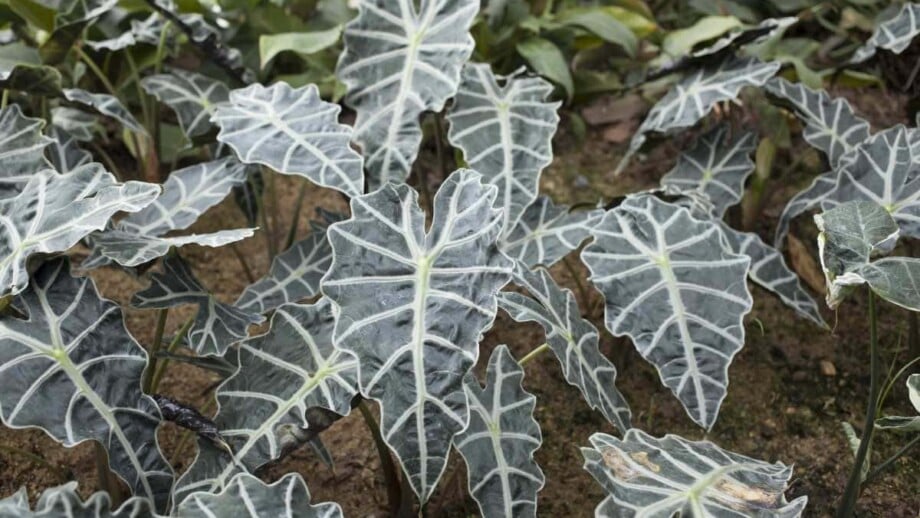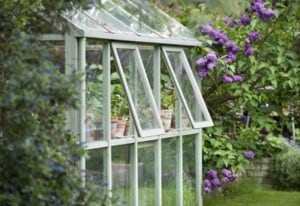Alocasia houseplants are renowned for their unique and beautiful foliage and can add visual appeal to just about any room in your house.
They have a powerful presence, and you won’t be able to help but be drawn by their captivating appearance and incredible charm. It’s no wonder that they’re such a well-loved houseplant!
The broad, heart or arrowhead-shaped leaves of this plant are textured and may have flat or wavy edges. The distinctive cream color veining stands out dramatically against the dark green color of the leaves.
Growing and caring for Alocasia houseplants doesn’t have to be tricky; read this guide to learn exactly what you need to do to grow them easily at home.
Botanical Name: Alocasia spp.
Common Name: Alocasia, elephant ears, African mask
Family: Araceae
Plant Type: Herbaceous perennial
Hardiness Zones: 10 – 12 (USDA)
Sun Exposure: Bright indirect light, outdoor shade
Soil Type: Loose, well-draining potting mix
Soil pH: 5.5 – 6.5 (Slightly acidic)
Height: 2 – 9 ft
Bloom Time: Spring and summer
Flower Color: Light yellow
Native Area: Asia and Eastern Australia
Quick Guide: Planting, Growing & Caring for Alocasia
- Alocasia is a subtropical plant hailing from Asia and Eastern Australia
- There are more than 100 different species and many are grown indoors as houseplants
- They should be kept moist but not waterlogged, and they also prefer humid environments
- Use a potting soil mix that’s loose, has good drainage, and is slightly acidic
Alocasia Plant Care
Alocasia plants can grow quickly, even in northern climates with a short growing season. These plants are capable of producing a new leaf every week during the warm summer months, and each new leaf may be twice as large as the leaf that was produced the week before.
The shapes of the leaves can range from thin arrowheads to wide heart-shaped leaves. The veins can be different colors, and the leaves can be thick, waxy, smooth, or glossy.
When the plant goes dormant in late fall and winter, it will start to rest. There will be no more rapid leaf growth, and the plant will probably keep its current form all through the colder months. If you keep taking care of it, it will grow quickly again the next season.
It’s important to note that alocasia is poisonous to people as well as animals, so make sure to keep them away from children and pets. They’re also known as the African Mask plant, or Elephant Ear plant.
Light
Depending on the species and variety, light requirements range from shade to full sunlight. Find out if the plant has been sun-trained by the grower or seller. Plants that require more light to thrive typically have more vibrant leaves.
The majority of Alocasia species are able to survive in shade, but they typically prefer slightly rosier filtered sunlight. The larger varieties can be conditioned to withstand the intense tropical sun. However, most indoor varieties grow best in bright, indirect light so keep it in a sunny room but away from direct sunlight.
Soil
Alocasia should be planted in potting mix that is loose and has good drainage, or in crumbly, loamy soil. They like soil that is slightly acidic, which is what you get with a standard potting mix made of peat.
Water
Alocasia plants need to be kept moist all year long because they love water. However, there is a fine line when it comes to these plants.
The soil should be kept moist but not drenched and soggy as soggy soil can lead to root rot. Since the plant is dormant during the winter, it’ll need less water during that time.
Before you water, let the top few inches of the soil almost dry out. This will help maintain soil moisture levels and prevent it from becoming soggy which can expose the plant to fungal infections.
Alocasias are known to be sensitive to the salts, minerals, and chlorine found in tap water, which can cause the plant to spot.
Before watering the plant, let the water sit for a full day in a bucket or watering can which can allow some of the unwanted substances to evaporate. Distilled water is another option you can use to water these plants.
Temperature and Humidity
Less than 60 degrees Fahrenheit will be harmful to your alocasia plants. During colder weather, certain varieties will die back and regrow from the rhizome. They need high humidity environments to survive and thrive.
Place your plant on a pebble tray and fill the tray with water until it reaches an inch or two below the bottom of the pot. This will increase the humidity in the area. Alternatively, you can use a humidifier. Keep them away from cold drafts from doors, windows, and air conditioners.
Fertilizer
Alocasia, especially the larger varieties, can be heavy feeders. During the growing season, liquid fertilizer should be applied once or twice per month.
A 20-20-20 NPK formulation is recommended.
Pruning
To prune an Alocasia, simply remove any leaves that have faded. It is natural for old leaves to wither and fall off as new ones emerge on a plant.
Types of Elephant Ear
There are about 100 different species of Alocasia and many of them are used as houseplants. Here are some of the most popular ones:
- Alocasia amazonica: This specie is also known as Alocasia Polly and is a compact 18-inch plant that features wavy, arrow-shaped red leaves.
- Alocasia ‘Zebrina’: This is a popular hybrid variety that features arrow-shaped leaves and leggy, zebra-like stalks. While it starts as a relatively small plant, it can grow to become quite large over time.
- Alocasia reginula ‘Black Velvet’: This is a stunning variety that features dark green foliage with white veins. It’s a compact plant that stays under 18 inches.
- Alocasia macrorhiza: This alocasia variety is rightly called giant taro as it is the largest of the houseplant species and can grow up to, 15 feet tall with 3 to 4 foot long leaves.
- Alocasia longiloba: This variety is also known as tiger taro and features dark gray-green leaves with white veins. It grows to about three feet fall.
- Alocasia cuprea ‘Red Secret’: This variety features metallic bronze-red leaves and can grow up to 3 feet tall.






How to Plant and Grow Alocasia (Elephant Ear)
How to Grow Alocasia From Seed
This plant is extremely simple to propagate rapidly through root division, so it isn’t usually grown through seeds.
However, if you have a fully grown plant that blooms and produces seed pods, you can harvest the seeds from the pods once they have dried out and then plant them in a nutrient-dense potting mix that contains peat.
Plant the seeds on the surface of the medium, and then cover them with a light coating of additional potting soil. Keep the soil moist, but not soaked, until the seeds sprout.
However, remember that it may take years for seedlings to mature into fully grown plants with characteristically enormous leaves.
How to Propagate Alocasia
The majority of Alocasia plants can be easily propagated by clump or rhizome division, which will result in a large number of new plants. Propagate in the spring, as this is the time of year when plants are actively growing, and doing so will enable you to increase the overage of this plant in your garden.
Dig up your plant with a trowel and select root clumps that have grown larger over time to increase the likelihood that there will be an adequate supply of rhizomes for division.
Cut off pieces of the underground rhizome using pruners that have been thoroughly cleaned, and then plant each piece in its own pot of moist potting mix.
It usually takes a couple of weeks for new growth to begin, so keep the pots warm and moist until then. When you give them a little tug and they have enough roots to resist, they are ready to be planted in a pot.
Common Pests and Plant Diseases for Alocasia Plant
Alocasia plants are rarely affected by diseases. However, spider mites and mealybugs are common in most Alocasia species. Their large leaves are also susceptible to being torn off by strong winds, so consider keeping them in a sheltered location, particularly during storms.
Other House Plant Guides from Planet Natural:
How to Plant, Grow, and Care for Calathea Plant Indoors
Types of Pothos: 15 Varieties to Consider Growing Today
ULTIMATE GUIDE to Stephania Erecta Care from Dormancy to Sprouting – All You Need to Know!











